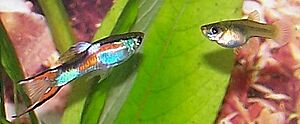John Endler facts for kids
Quick facts for kids
John Endler
|
|
|---|---|
| Born |
John Arthur Endler
1947 (age 77–78) |
| Alma mater | University of Edinburgh (PhD) |
| Scientific career | |
| Fields | |
| Thesis | A Study of Morph-Ratio Clines (1973) |
| Doctoral advisor | Bryan Clarke |
John Arthur Endler (born in 1947) is a Canadian scientist. He studies how animals behave (this is called ethology). He also studies how living things change over many generations (this is called evolutionary biology). Dr. Endler is famous for his work on how animals adapt to their unique surroundings. He also studies how their senses and color patterns change together over time. This process is known as co-evolution.
Contents
Early Life and Education
John Endler was born in Canada. He earned his PhD degree from the University of Edinburgh in Scotland in 1973. A PhD is a very high university degree.
Career and Research Discoveries
After finishing his PhD, Dr. Endler worked at several universities around the world. He worked at Princeton University from 1973 to 1979. Then he moved to the University of Utah (1979-1986). After that, he was at the University of California, Santa Barbara (1986-2006). He also worked at James Cook University in Australia.
In 2006, he became a professor at the University of Exeter in England. In 2007, he was chosen as a Fellow of the American Academy of Arts and Sciences. This is a group that honors important thinkers. Since 2009, he has been an Alfred Deakin Professor at Deakin University in Australia.
Studying Guppies and Evolution
Dr. Endler has done a lot of research on small fish called guppies. In 1975, he "rediscovered" a type of guppy. This fish is now known as Endler's guppy in his honor. This brightly colored fish is sometimes thought to be a different version of the common guppy. However, it is usually seen as its own species, Poecilia wingei. Even though others had seen it before, Dr. Endler was the first to properly study and write about it.
Among other scientists, he is well-known for his experiments. He showed how small-scale evolution can happen in a laboratory. This means he could see changes in animals over a short time.
Other Animal Studies
Besides guppies, Dr. Endler has studied many other animals. He investigated the interesting behavior of bowerbirds in North Queensland, Australia. These birds build special structures called "bowers" to attract mates.
Awards and Recognition
Dr. Endler has received many important awards for his work.
- In 2008, the European Research Council gave him an Advanced Grant. This award helps scientists do important research.
- In 2012, he was elected a Fellow of the Australian Academy of Science.
- In April 2020, Dr. Endler was elected a Fellow of the Royal Society (FRS). This is a very old and respected scientific group in the United Kingdom.
- In 2021, he and Susanne von Caemmerer won the first Suzanne Cory Medal for Biomedical Sciences.
Dr. Endler's work on guppies in Trinidad was featured in a popular science book. The book, published in 1995, was called The Beak of the Finch.
Key Publications
Dr. Endler has written important books and many scientific articles.
Books
- Endler, John A. (1977). Geographic Variation, Speciation, and Clines. This book is about how animals change in different places.
- Endler, John A. (1986). Natural Selection in the Wild. This book explains how nature chooses which animals survive and reproduce.
Journal Articles
- Endler, J. A. (1980). Natural selection on color patterns in Poecilia reticulata. This article describes how guppy colors change due to natural selection.
- Endler, J. A., & Day, L. B (2006). Ornament colour selection, visual contrast and the shape of colour preference functions in great bowerbirds, Chlamydera nuchalis. This paper looks at how bowerbirds choose colors.
- Endler, J. A., & Mielke, P. W. (2005). Comparing entire colour patterns as birds see them. This research explores how birds see colors.


